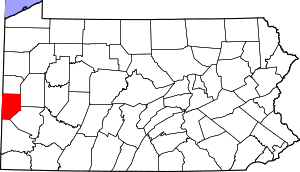Darlington, Pennsylvania
Darlington is a borough in Beaver County, Pennsylvania, United States. The population was 254 at the 2010 census. It is part of the Pittsburgh, PA Metropolitan Statistical Area.
Darlington, Pennsylvania | |
|---|---|
| Borough of Darlington | |
 Veterans Memorial in central Darlington | |
 Location in Beaver County and the U.S. state of Pennsylvania. | |
| Coordinates: 40°48′36″N 80°25′24″W | |
| Country | United States |
| State | Pennsylvania |
| County | Beaver |
| Settled | 1804 |
| Incorporated | 1820 |
| Government | |
| • Type | Borough Council |
| Area | |
| • Total | 0.08 sq mi (0.21 km2) |
| • Land | 0.08 sq mi (0.21 km2) |
| • Water | 0.00 sq mi (0.00 km2) |
| Population (2010) | |
| • Total | 254 |
| • Estimate (2017)[2] | 241 |
| • Density | 2,939.02/sq mi (1,137.00/km2) |
| Time zone | UTC-5 (Eastern (EST)) |
| • Summer (DST) | UTC-4 (EDT) |
| Zip code | 16115 |
| Area code(s) | 724 |
| FIPS code | 42-18192 |
| Website | http://darlingtonborough.com/ |
History
Darlington was settled in 1804 and incorporated on 28 March 1820, as Greersburg. It adopted its current name on 6 April 1830. Darlington is named for S. P. Darlington, a merchant from Pittsburgh.[3]
Geography
Darlington is located at 40°48′36″N 80°25′24″W (40.809917, −80.423381).[4]
According to the United States Census Bureau, the borough has a total area of 0.1 square miles (0.26 km2), all of it land.
Demographics
| Historical population | |||
|---|---|---|---|
| Census | Pop. | %± | |
| 1860 | 301 | — | |
| 1870 | 280 | −7.0% | |
| 1880 | 247 | −11.8% | |
| 1890 | 254 | 2.8% | |
| 1900 | 270 | 6.3% | |
| 1910 | 311 | 15.2% | |
| 1920 | 347 | 11.6% | |
| 1930 | 465 | 34.0% | |
| 1940 | 444 | −4.5% | |
| 1950 | 354 | −20.3% | |
| 1960 | 306 | −13.6% | |
| 1970 | 344 | 12.4% | |
| 1980 | 377 | 9.6% | |
| 1990 | 311 | −17.5% | |
| 2000 | 299 | −3.9% | |
| 2010 | 254 | −15.1% | |
| Est. 2017 | 241 | [2] | −5.1% |
| Sources:[5][6][7] | |||
At the 2000 census there were 299 people, 122 households, and 79 families residing in the borough. The population density was 3,217.7 people per square mile (1,282.7/km²). There were 130 housing units at an average density of 1,399.0 per square mile (557.7/km²). The racial makeup of the borough was 97.99% White, 0.67% Asian, 0.67% from other races, and 0.67% from two or more races. Hispanic or Latino of any race were 0.67%.[6]
There were 122 households, 28.7% had children under the age of 18 living with them, 51.6% were married couples living together, 11.5% had a female householder with no husband present, and 35.2% were non-families. 32.0% of households were made up of individuals, and 16.4% were one person aged 65 or older. The average household size was 2.45 and the average family size was 3.14.
In the borough the population was spread out, with 23.4% under the age of 18, 11.0% from 18 to 24, 26.4% from 25 to 44, 21.1% from 45 to 64, and 18.1% 65 or older. The median age was 38 years. For every 100 females, there were 83.4 males. For every 100 females age 18 and over, there were 73.5 males.
The median household income was $30,125 and the median family income was $38,750. Males had a median income of $25,625 versus $22,000 for females. The per capita income for the borough was $15,938. About 3.9% of families and 9.2% of the population were below the poverty line, including 10.9% of those under the age of eighteen and 9.7% of those sixty five or over.
References
| Wikimedia Commons has media related to Darlington, Pennsylvania. |
- "2017 U.S. Gazetteer Files". United States Census Bureau. Retrieved Mar 24, 2019.
- "Population and Housing Unit Estimates". Retrieved March 24, 2018.
- Gannett, Henry (1905). The Origin of Certain Place Names in the United States. Govt. Print. Off. pp. 100.
- "US Gazetteer files: 2010, 2000, and 1990". United States Census Bureau. 2011-02-12. Retrieved 2011-04-23.
- "Census of Population and Housing". U.S. Census Bureau. Retrieved 11 December 2013.
- "U.S. Census website". United States Census Bureau. Retrieved 2008-01-31.
- "Incorporated Places and Minor Civil Divisions Datasets: Subcounty Resident Population Estimates: April 1, 2010 to July 1, 2012". Population Estimates. U.S. Census Bureau. Archived from the original on 11 June 2013. Retrieved 11 December 2013.
